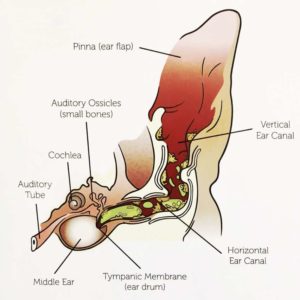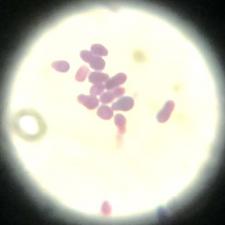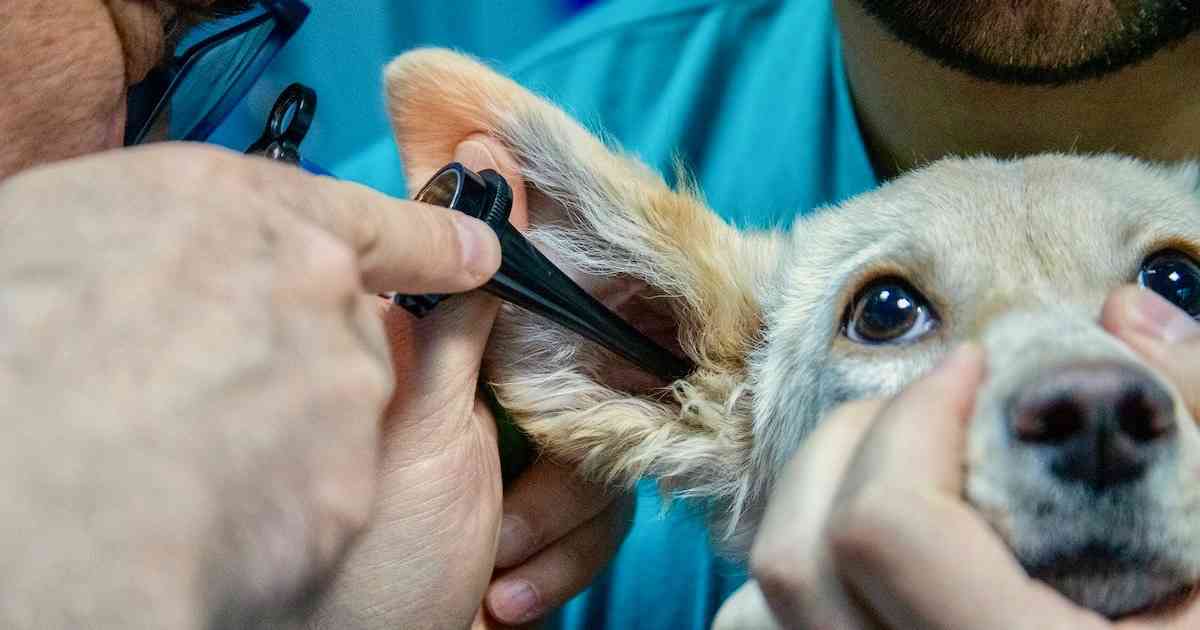Updated June 3, 2021
Essential facts (details below):
Steps In The Treatment Of Ear Infections
- Medication chosen for the type of infection
- Treatment for pain and inflammation
- Regular follow-up until resolution
- Treatment of the underlying factors you can control
Now dive deeper…
When I was a young vet, I worked in a clinic that offered an emergency service, and one thing surprised me more than anything else: the number of ear infections.
Ear infections are the most common problem of dogs, but are they an emergency? Clearly the answer can be yes. Despite taking a few days to get going, they can end up causing so much pain that sometimes these dogs need help straight away.
All the more reason to treat them before that happens. Here I’m going to focus only on the best treatments for canine ear infections. I’ve written much more about why they happen, and how to stop them coming back at these two related pages:
Signs Of An Ear Infection
Dogs with inflammation of the ear show some or all of the following:
- Shaking the head
- Scratching at the ears
- Redness around the ear opening
- A brown or yellow ear discharge
- A smell from the ears
- A head tilt
- A swelling of the ear flap (we call this an aural haematoma)
You may only be given one clue such as head shaking or a musty smell, and the ear may look perfectly normal on the outside. So here’s a rule:
If the ear smells different to the rest of the dog, there’s something wrong.
So many dogs come in to me for another problem, and as soon as they walk into the room I either smell them or see them flick their head. These owners have got used to the warning signs and don’t realise what they’re missing. Almost always, the next thing I say is:
To your dog, the big problem is his ears, not what you came here for. Ear infections are painful, but dogs hide chronic pain so well that even good owners miss it completely. Those emergencies I mentioned only happen when the infection comes on fast or something changes.
Treatment Of Ear Infections
Start with a trip to the vet. It’s the only way to treat ear infections properly. This is what they might do:
Physical Exam
When I see a painful ear, I always start by examining everything else first. I want to know about your dog’s general state of health, and look for reasons why the ear infection developed in the first place. You’ll find these listed here.
Next, I look in the other ear. This is rarely as normal as it looks on the outside. Even if it is, it shows me what the bad ear looked like before it got infected.
Finally, I examine the infected ear. Have a look at how the assistant is holding the dog’s muzzle at the start. This is essential to prevent your dog shaking their head while the otoscope is inside. A badly performed ear exam can leave a dog never trusting their ears to be checked again.
To Sedate Or Not?
Sometimes dogs have already had too many bad experiences to allow examination. Other times, it’s just too painful to examine well.
There are also the anxious dogs, who often just won’t allow inspection. Even if they do, they always need special handling to prevent them getting worse each time they come.
Finally, especially in Spring and Summer when an ear suddenly gets painful after a walk, a grass seed in the ear canal is likely.
All these dogs need to be given a sedation for examination. It’s a humane act, and can usually be done on the spot.
To Anaesthetise Or Not?
Sometimes the infection is bad enough that there is a real risk of ear drum rupture. This is especially likely if pus is present. Whenever possible, these dogs should be fully anaesthetised for a gentle saline flush of the ear canal.

Other times (like the picture) there’s so much thick discharge that the chance of fixing the infection without first cleaning the ear is very low. An ear clean is optional here but will certainly speed things up and may end up being necessary anyway. You don’t want to spend 3 weeks fruitlessly battling away only to then schedule an ear clean.
An ear clean is also needed when an owner will have trouble putting ointments in their dog’s ear at home. Ear cleaning gives everyone a head start so that less-than-perfect treatment can still work. It’s also essential if we want to use the long-acting ear gel called Osurnia®.
Most vets will only flush infected ears under a full anaesthetic as it seems especially painful.
Ear Cytology & Culture

Anaesthesia or sedation aren’t necessary for most dogs, but they certainly need the next procedure: ear cytology. This is a sample of ear discharge stained and examined under the microscope. Here’s one showing budding Malassezia yeasts.
Cytology allows us to choose the best treatment. Most ointments contain both antifungals and antibacterials but each ingredient has its strengths and weaknesses. For example, the antibiotic polymyxin is nearly useless against anything serious like Staphylococcus or Pseudomonas.
If cytology shows rod-shaped bacteria, I will always advise that we send away a bacteriological swab for culture and sensitivity testing. While not compulsory, it’s money well spent as these bacteria are unpredictable and nasty. The test allows us to choose the right antibiotics the first time.
Ear Infection Medicines
The cornerstone of treatment (unless the ear drum is ruptured) is an appropriate ear ointment. I hope you can see by now why we never just prescribe ointment for a new infection over the counter.
Drops will need to be applied deep into the ear once or twice a day depending on the product. Always get a vet or nurse to show you how it’s done. Most treatment failures are as a result of owners incorrectly applying the ointment. If it seems too hard, many nurses are happy to put the ointment in for you each day at no charge if you can come in to the clinic.
Resist the temptation to use that leftover ointment from the last ear infection. Expiry dates only apply to unopened medicines and it may not be the right ointment for this infection. Both factors lead to the rapid development of antimicrobial resistance and substandard treatment.
Sometimes we will also add oral medicines or injections. These can be pain relief for especially bad ears, short-term prednisolone to reduce ear canal swelling, or antibiotics for severe bacterial infections. However, tablets on their own will never fix an ear infection.
Follow Up
The biggest mistake dog owners make is thinking that if the ear canal looks good on the outside, then the infection must be fixed. Many of these dogs come back in a few months with what looks like another ear infection, but is actually the same one reappearing.
Revisit appointments aren’t just formalities. 50% of the dogs I see one week later still require further treatment. Often the owners need to adjust their technique, sometimes a different medicine is needed, or it might just need a longer time.
Occasionally we have misjudged the cause of an infection, and can see it now the ear canal is cleaned up. This is especially true when a grass seed gets in an ear out of the normal season.
If I see a long-term chronic ear infection, I will warn the owner that we’ll be checking this dog week after week until it’s fixed. I’ve taken many dogs who seemed to have unfixable ears and proven that all that was needed was a dogged determination to take the problem to its conclusion.
To Clean Or Not?
Many vets and specialists recommend using an ear cleaner before each ointment dose. I rarely see the need nor the benefit. Home ear cleaners are pretty terrible at removing discharge from the horizontal part of the ear canal. According to me, the ear canal is either reasonably clean, or it should be fully flushed before starting.
I have a completely different attitude to long-term cleaning once the infection is under control. But it’s not one-size-fits-all.
It’s essential that you don’t try to treat a painful ear with acidic products for obvious reasons. This means you shouldn’t use them once an infection starts, which means even if it’s just smelly. They’re preventers only.
Which Ear Cleaner?
Dogs prone to yeast overgrowth can do well with certain cleaners applied once to twice weekly. My personal favourite is Virbac’s Epi-Otic® but you can read my reviews and the evidence for many ear cleaners here.
Dogs prone to bacterial overgrowth are often worsened by the same cleaners. For these, I use a neutral, antibacterial ear wash called Otoflush®.
What I used to do but never any more is make a mix of anti-fungal shampoo (Malaseb®) and water. It rarely worked, and we were always in danger of swapping an easy problem (yeast) for a nightmare one (Pseudomonas).
There are countless other products available, such as Thornit and Zymox. Nothing works on every dog, neither these nor my own preferences. Therefore, keep in contact with your vet and get the results checked.
It’s always a joy when a dog owner comes in a month or two after an ear infection just to check their progress. It’s quick, it’s cheap, and it’s pain free.
Now Read: How To Clean a Dog’s Ears | TECA: The Last Resort I Hope You Never Need
Have something to add? Comments (if open) will appear within 24 hours.
By Andrew Spanner BVSc(Hons) MVetStud, a vet in Adelaide, Australia. Meet his team here. The information provided here is not intended to be used as a substitute for going to the vet. If your pet is unwell, please seek veterinary attention.


Is it ok to use trizultra+ keto on a clean rag to wipe the ear? My 3 year old pup has required sedation for every ear infection he’s had and will not tolerate the flush (nor can we do it because it seems to be so hard on him) but will let me hold it as a compress. Appointment is booked, just trying to help my boy in the meantime!
Hi Katie. I’m sorry, I just can’t say without knowing the condition of the inside of the canal. Everything can do harm if used in the wrong ear.
Hi there, We have a near 6 year old red kelpie who has continual ear problems. She is a very anxious dog when going to the Vet! We have to drug & muzzle her! She’s had anaesthesia & underwent an ear flush & was treated with antibiotics in 23/1/23.. Within a few weeks, she was back to ear infections. We’ve tried changing her diet to Hills Science Derm Care & stopped her steamed chicken. In May she had more antibiotics! She now has a haematoma from scratching too much & her ear is weighted down -flopping over from this. PLEASE HELP!
Hi Michelle. You might hopefully benefit from looking at some of the other pages you will access from links here. Particularly, you are following the very low yield path of trying dietary manipulation, which seldom works. Most of these dogs need systemic treatment for their atopic dermatitis as well as very rigourous control of the ear infections. Obviously, with an anxious dog that is extremely difficult to ever do well but the development of Neptra has made it a lot easier. If an infection is only 99% fixed, it is as good as not fixed at all and will keep recurring. The current situation of a haematoma usually needs surgical repair which is a good place to start.
My mini dachshund has had treatment at the vet osurnia gel inserted over 2 weeks. He has advised using Epiotic after 7 days. My girlfriend suggested Zymox which is more expensive and a dachshund member suggesed Triz ultra plus keto which is even more expensive. Wondering if that is over kill any advice would be great
Hi Sharon. These two treatments are not available in Australia, but I swear by Epi-Otic as a first-line prevention of yeast infections, such as are very common in the Dachshund. I think it’s sensible to start simple; you can always ask your vets about the other options if things are not going to plan.
I have a cockerpoo, & when her ears get dirty/grimey I dip a cotton bud in Bio oil to clean & wipe with a soft cloth/ tissue. If there was any redness, it goes away. She’s 6.5yrs & so far no ear infections.